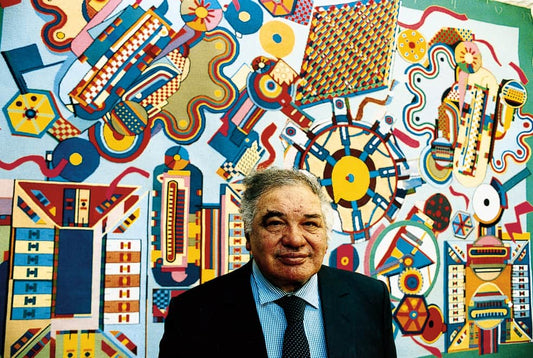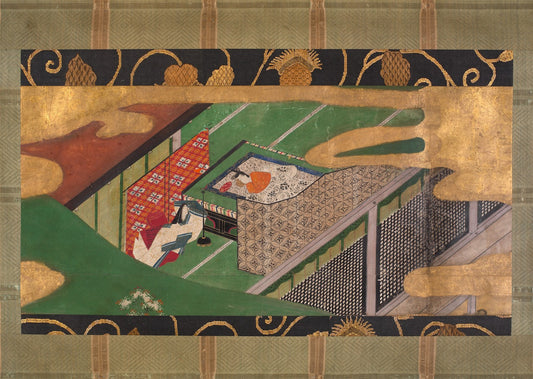Norman Rockwell, Explained
In 2024, Norman Rockwell might be more known for his name than for his artistic works. He has become ubiquitous as an American artist for his honest depictions of American life and culture. “Rockwellesque” was coined to designate other artworks similar in style to his. Opinions of Rockwell’s paintings of early to mid-20th century American life range from bland and generic to unflinchingly satirical, criticizing the values of the country Rockwell’s work has now come to embody.
So, who was Norman Rockwell? Why do his works evoke such divisive opinions? How did he become so heavily associated with Americana? And what’s the deal with that Lana del Rey album named after him? Learn all this and more as we journey into the life and career of one of America’s most prolific painters.

Who was Norman Rockwell?
Norman Percival Rockwell was born in New York City on February 3, 1894. A lifelong artist, he began his foray into the art world at 14 years of age, enrolling at the Chase School of Art to become a professional illustrator.
In 1913, when Rockwell was just 19 years old, he created the inaugural cover of Boys’ Life (now called Scout Life), the official magazine of the Boy Scouts of America. This spawned a 64-year relationship with the Boy Scouts of America, drawing cover illustrations for the magazine for three years, becoming its editor, and creating their calendars until 1977.

In 1916, Rockwell began his career with The Saturday Evening Post, for whom he illustrated 321 covers that would appear in the magazine until 1963. Rockwell also contributed to other publications like Literary Digest, Life, Leslie’s Weekly, and LOOK. During this period of his career, particularly during his time with The Saturday Evening Post, art critics and laypeople alike often called Rockwell’s cover illustrations “bourgeois,” “kitsch,” “homey,” and “low art” as they depicted an idealized, whitewashed version of peacetime American family life. Some of his most famous Saturday Evening Post covers include Pardon Me (1913), Saying Grace (1951), and John F. Kennedy In Memoriam (1963).
“Without thinking too much about it in specific terms, I was showing the America I knew and observed to others who might not have noticed,” Rockwell said of his work.
Rockwell was awarded the Presidential Medal of Freedom by President Ford in 1977 for “vivid and affectionate portraits of our country.” He died November 8th, 1978, in Stockbridge, Massachusetts.
Notable Works in Context
Much of Rockwell’s works rely on appealing to the political and popular culture of the time. His later works increasingly focused on current events. Examining them in context is key to understanding Rockwell’s appeal.
The Four Freedoms (1943)
Painted over seven months in 1943 during World War II, The Four Freedoms series was inspired by President Franklin D. Roosevelt’s State of the Union address in January 1941. In the speech, President Roosevelt outlined four freedoms that must be protected, including freedom of speech, freedom of worship, freedom from want, and freedom from fear. Each oil painting in Rockwell’s Four Freedoms series has become iconic on its own but is meant to be viewed in conversation with one another.
Freedom of Speech
In the first painting in the series, Freedom of Speech, which was published on February 20, 1943, a man is seen standing voicing his opinion at a town hall. The crowd of people surrounding him are all intently focused on his confident delivery. Rockwell considered this and Freedom of Worship to be the most successful of his series.

Freedom of Worship
The second painting, Freedom of Worship, published on February 27, 1943, depicts several people of different faiths praying together. The three figures in the foreground include a Jewish man, a Protestant woman, and a Catholic woman. The text “Each according to the dictates of his own conscience” is also featured on the upper edge of the scene. Rockwell was particularly concerned with how he depicted each person of faith, stating, "Religion is an extremely delicate subject. It is so easy to hurt so many people’s feelings.”

Freedom from Want
President Roosevelt defined freedom from want in his State of the Union address as “economic understandings which will secure to every nation a healthy peacetime life for its inhabitants—everywhere in the world.” Rockwell’s interpretation, published on March 6, 1943, featured a traditional family gathering at Thanksgiving. An older woman is seen serving a turkey as a large family eagerly awaits dinner, appearing to enjoy each other’s company. Freedom from Want has been heavily parodied and referenced since its first publication, becoming popular immediately, and is undoubtedly the most successful in the series in terms of recognizability.

Freedom from Fear
President Roosevelt called for “a worldwide reduction of armaments to such a point and in such a thorough fashion that no nation will be in a position to commit an act of physical aggression against any neighbor — anywhere in the world” when defining freedom from fear. In Rockwell’s depiction, parents tuck their child in for bed as the father clutches a newspaper with headlines about the ongoing bombings in the U.K. known as “the Blitz” at the time.

The Problem We All Live With (1964)
Rockwell’s January 1964 illustration for Look magazine, The Problem We All Live With, depicts an important moment in the history of the Civil Rights Movement. Just four years earlier, in 1960, Ruby Bridges, a Black 6-year-old girl, was escorted to a hostile, all-white elementary school by federal marshals as the city of New Orleans, Louisiana, resisted integration. In the background, racial slurs and “KKK” are written on the wall behind Bridges. The title acknowledges that the racism and cruelty shown towards Black children amidst the ongoing Civil Rights Movement was a problem white Americans needed to confront.

After the illustration was published, Rockwell received “sacks of disapproving mail” and was called a race traitor. Later that year, in July 1964, the Civil Rights Act went into effect and prohibited discrimination based on race, religion, sex, and national origin.
The painting was displayed in the White House to honor the 50th anniversary of Bridges’ walk to school in 2011, at Bridges’ suggestion. President Obama and Bridges viewed the painting together in July of that year, with the former president telling Bridges, “I think it's fair to say that if it hadn't been for you guys, I might not be here, and we wouldn't be looking at this together.”
New Kids in the Neighborhood (1967)
This illustration, created for Look magazine, depicts suburban integration in Chicago’s Park Forest neighborhood. A Black group of children who have just moved in stand facing the white children already living on the block, wanting to play baseball with each other. Looking closely, one can see adults in the neighborhood in the background peering through the windows, clearly wary of the interaction. This piece further showcased Rockwell’s stance on tolerance and holding up a mirror to his viewers’ hypocrisies when it came to race relations post-Civil Rights Act.
Contemporary Perspectives
Today, opinions on Rockwell still vary. The contrast between his earlier works of quaint, suburban family life in pre-WWII America and his later ones that tackled American issues of racial violence and segregation head-on is often noted. His unique realistic style of narrative art that stemmed from his experience as a magazine cover illustrator distinguished his paintings from other 20th-century realist artists. One technique he employed to better illustrate his narratives within his paintings was the use of reference models.
Of course, Rockwell still has his critics, even today. “Rockwellesque” or “Rockwellian” are pejorative terms that refer to art that overly idealizes American life.
References in Pop Culture
Norman Rockwell’s works depicted a wide array of subjects in his distinct, vivid style, providing reference and inspiration for a myriad of other artists and creators. Several of these references are recent, debuting in the past five years, showcasing the slight resurgence of interest in Norman Rockwell.
Lana Del Rey’s 2019 album Norman Fucking Rockwell ! and its title track are named after Rockwell. He is also referenced in the song “Venice Bitch”. On the album’s title, Del Rey described how she and producer Jack Antonoff landed on the name in a 2019 Vanity Fair interview: “I was riffing over a couple of chords that Jack [Antonoff] was playing for the title track, which ended up being called ‘Norman Fucking Rockwell.’ It was kind of an exclamation mark: so this is the American dream right now. This is where we’re at—Norman fucking Rockwell. We’re going to go to Mars, and Trump is president, all right [...] it’s a slight cultural reference. But it’s not a cynical thing, really.”
As a nod to Rockwell’s most frequently recreated and lampooned piece, Disney has parodied Freedom from Want using Mickey Mouse and friends twice—once in 1993 in an illustration by Charles Boyer, and again, controversially, in 2023, facing speculation that the image was AI-generated.
In late 2022, Freedom of Speech became a meme on Twitter, with users attaching the image to their posts proclaiming their unpopular and controversial opinions. “Rail transit is more comfortable than even the highest quality bus service,” one user captioned the Rockwell piece. Another user criticized how people were “incorrectly” using the painting by playing into the meme as well: “A lot of you people don't seem to realize that the Norman Rockwell meme is supposed to be for opinions that are actually unpopular.”
Once hailed as an honest depictor of Americana, Norman Rockwell, and his works are now used for satirizing the very sanitized, idealized version of America he originally depicted. Many still see the value in Rockwell’s work, though, like directors Stephen Spielberg and George Lucas. Whatever one’s thoughts on Rockwell’s works—whether kitsch or genuine—it’s clear that his legacy and influence cannot be minimized.
©ArtRKL™️ LLC 2021-2024. All rights reserved. This material may not be published, broadcast, rewritten or redistributed. ArtRKL™️ and its underscore design indicate trademarks of ArtRKL™️ LLC and its subsidiaries.







